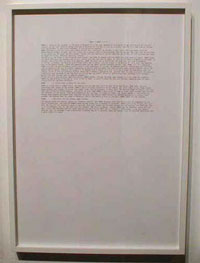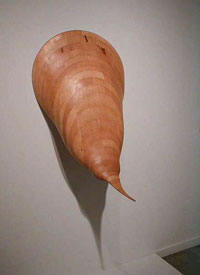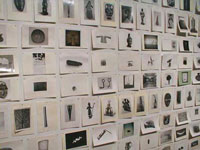From Leonardo’s landscapes based on cracks in plaster walls to Jean Arp’s scattered paper collages, artists have always sought fresh visual forms by inventing systems that distance themselves from their creations.
In today’s art world, supersaturated with words, systems have another benefit: reams of readymade verbiage about the system make it easy to avoid talking about the work itself. At the CAM, the wall tags, catalog and available reference materials provide a blizzard of information about the artists” processes, and almost nothing about their works” actual effects. I won”t waste space in this review regurgitating the artists” schpiels about how their pieces are made; this information is intentionally obfuscating, not illuminating. In this show, only Emma Kay’s Shakespeare From Memory packs enough conceptual punch to avoid being buried in BS.
Loren Madsen’s Cost Price Index graphs economic data in polished wood. Elegant materials imply careful research, but it fails to add much to one’s understanding of changing economic conditions and ends up looking like a giant wasp abdomen. The piece succeeds in depicting a dramatic price increase over a period of time, but in the end, Cost Price Index is more about woodworking than economics. Likewise, Madsen’s Long Scroll doesn’t say much about how Madsen has spent his days, despite a myriad of little calendar squares.
Mark Lombardi’s drawings combine the paranoia of a confirmed conspiracy theorist with the elegant draftsmanship of a frustrated architect. Typical of the conspiracy theory genre, the works rely on innuendo, not information. In one drawing we are told that a lot of people are connected to the Lippo Group, but not what they did, or whether they are guilty of anything. Like hapless news consumers we are given tantalizing headlines, but never get the real story.
Matthew Ritchie builds complex tangles of graffiti-style marker moves, studded with comic book figures and cryptic pseudo-equations, all based on a complex, hermetic cosmology. Like Pokemon, Ritchie’s world-system thrives on baroque complexity for its own sake, distracting criticism from the disappointingly dull surfaces and indifferent paint dabbing which make these pieces much better from a distance than close up.
Steeped in the dusty, genteel aura of museology, William Steen’s The Master File presents a trophy wall of file cards from the archives of The Menil Collection. On each card, a photo of an artwork is isolated, standardized, and displayed, becoming a trading card to be arranged, compared, hoarded. Steen’s piece has the pride of vicarious ownership shared by museum employees everywhere.
Emma Kay’s subject is herself. Writing down all she can remember of shared cultural icons like The Bible or Shakespeare’s plays, she allows us to compare our knowledge with hers, laughing at her funny mistakes where we know better, enjoying a sheepish dumb-and-dumber camaraderie where we’re both ignorant. Together we English-speakers trace out the contours of shared culture, confirming our sense of identity by comparing our education and backgrounds. Kay’s pieces are a rare triumph of text art: I actually read several of her involved panels, despite their minimal visual interest. The tongue in cheek Shakespeare from Memory panels are the best. Bible List, a large panel of nouns abstracted from the bible, is too contrived to be funny.
Katy Heinlein: If and When
Lawndale Art and Performance Center
26 January – 3 March, 2001
In If and When, Katy Heinlein’s current show at Lawndale art and Performance Center, seven minimal structures made from pillows and boards push, pull and balance one another like Chinese acrobats in precarious dynamic situations. Each of Heinlein’s pieces is a sculpture of an event, rather than a static object. This sense of movement is inevitably anthropomorphic, each element becoming a character in a goofy slapstick comedy.
Heinlein’s understated critique of macho-man minimal sculpture (Heinlein recently spent time out at Donald Judd’s Chinati Foundation in Marfa, TX) bursts out in Prop, a long steel pipe which pins a lard-colored nylon pillow to the wall and makes a direct reference to a Richard Serra piece in which a similar steel pipe leans against a heavy steel plate. As in Serra’s piece, it is the implied instability of the configuration which makes it piquant- a precarious balancing of opposing forces which bring our instinctive awareness of gravity to the forefront of consciousness. The masculine-steel/feminine-fabric comparison is a bit simpleminded, but Heinlein doesn’t harp on it.
Heinlein sensitively chooses appropriate types of fabric for the roles each is to play in the work: industrial ripstop nylon for the weights in Cantilever, steel-colored taffeta for the supporting pillows in Stand, clingy fleece for the blocks in Sticky Fingers. She resists gaudy colors, choosing a drab industrial palette of gray, olive, ochre, and brown as if the pillows were neutral blobs in a physics experiment. The manufacture of the pieces is just right, neither fussy nor sloppy. Handsomely enameled lumber and workmanlike sewing give the pieces a matter-of-fact honesty in keeping with their lab-demonstration engineering.
The least successful pieces in the show, Situation and Cover, flirt with triteness by using fabric in expectable ways. Cover is a narrow pink mattress strapped underneath an avocado board, bringing to mind domestic uses of fabric in upholstery, bedding etc. Situation uses lumpy pillows to stand in for the body. The abject prone position and oozing blob give the piece a cutesy pathos.
Images appear courtesy the artists and galleries.
Bill Davenport is an artist and writer and was one of the first contributors to Glasstire.






